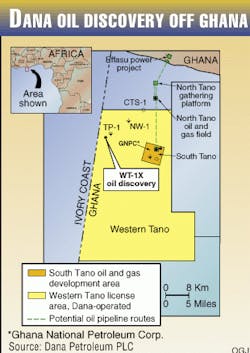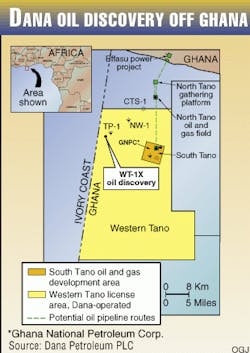Dana makes Offshore Ghana oil discovery
An oil discovery by Dana Petroleum PLC and Ghana National Petroleum Corp. (GNPC) on their first joint exploration well in the Western Tano contract area off Ghana indicates potential reserves in both shallow and deep waters, officials said.
The WT-1X well was drilled to 10,414 ft TD in 380 ft of water to explore both the Upper and Lower Cretaceous horizons in the shallow-water shelf region about 20 miles off Ghana. By testing reservoir development and source rock maturity in that area, company officials hoped to gain better understanding of the neighboring deepwater fan prospects.
Subsequent testing and wireline logging proved hydrocarbons are present in both sands, say the companies.
A drillstem test of a 150-ft gross oil column in a channel sand sequence in the Upper Cretaceous flowed as much as 1,000 b/d of clean oil with a gravity of about 20°. Bottomhole pressures indicated future development wells could produce at much higher rates by using artificial lift, according to the partners.
The Lower Cretaceous was entered at around 9,500 ft. Wireline logs and shows confirmed a lighter oil in porous sandstones with much higher pressures and gas levels than in the Upper Cretaceous.
Drilling continued to 10,000 ft in an effort to determine the total extent of the oil-bearing sands. However, the partners decided to halt drilling because of overpressure problems. They were unable to do a flow test on the Lower Cretaceous, and that lower section was plugged for safety reasons.
The discovery well has been temporarily suspended but may be used as a future oil producer, say the firms. However, they said future wells will be designed to accommodate the high pressures encountered in the lower levels, so that horizon will be flow-tested.
Meanwhile, results from that well will be integrated with GNPC's existing high-quality 3D seismic data for the area to determine the commercial significance of the discovery and plan for future work.
Well assessment
"The well is important not only for what has been tested and encountered, but even more for heralding what we see as a new chapter in unearthing Ghana's exploration potential. The location of these additional reserves near the North and South Tano fields is also significant for our development plans," said Tsatsu Tsikata, GNPC chief executive (see map).
GNPC currently has a 10% share of that discovery but can elect to increase its working interest to 25% during commercial development.
"Proving hydrocarbons within both the Upper and Lower Cretaceous horizons confirms our belief that there is considerable potential in the Western Tano area, both in the shallow-water and deepwater objectives," said Tom Cross, chief executive of Dana, one of the fastest-growing British independents.
Capitalizing on its regional experience in West Africa, Dana is operator of four major production-sharing contracts covering more than 36,000 sq km off Ghana and Mauritania. Additional licenses are being negotiated in that area, says the company.
Although the Western Tano well was Dana's initial oil strike in West Africa, it was the company's fifth consecutive discovery worldwide in less than 2 years. Since mid-1998, Dana has made significant oil or gas finds with four previous wells, including three in Europe and one in the Far East.
The company holds more than 50 oil and gas interests around the globe, with a strong focus in Europe and West Africa. It currently produces 6,000 b/d, with more than 70% of its earnings coming from its UK operations.

